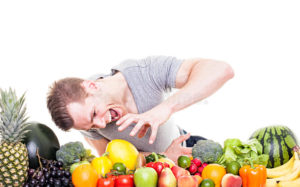
Can regular consumption of fruit and veg really reduce your risk of getting a stroke? If simply improving one’s diet to include fruit and veg could reduce that frightening number of destroyed lives, then it seems like something which governments and health authorities should be shouting about from the rooftops. But, before we get ahead of ourselves, is there any substantial evidence to prove that fruit and veg consumption is causally linked to reduced stroke risk?
There are now more than 100,000 strokes a year in the UK alone 1 with increasing numbers appearing in developing countries, possibly as their populations adopt the Western diet 2 . When you look at so-called ‘Blue Zones’ 3 4 – that is, those long-lived populations around the world (such as the Okinawans 5 ) who historically ate largely plant-based diets – you will see that the risk of having a stroke (and all other non-communicable diseases, for that matter 6 ) is significantly lower when compared to countries adopting the Western diet (also known as the SAD – standard American diet). But in order to ensure that we are talking about causation and not just association, we need to have research results that show a direct link between eating fruit and veg and a reduced risk of stroke.
Blog Contents
Does a causal link exist?
Such evidence of a causal link is revealed in a 2014 meta-analysis 7 which looked at data from 24 prospective cohort studies 8 up to 2014. Overall, the analysis of the results derived from the latter indicate that a causal link does appear to exist.
The following chart presents a list of the studies included:
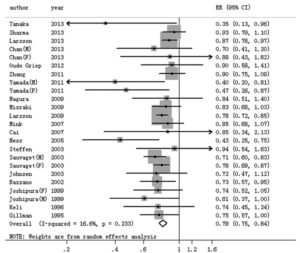
Fruit Consumption and Risk of Stroke
They found that the lowest levels of fruit consumption was inversely associated with the highest risk of stroke. That is, the less fruit you eat, the greater the chance of a stroke. This was shown in the following chart.
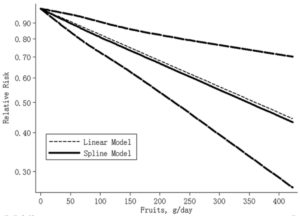
But how much fruit per day?
The above chart shows that the more fruit you eat, the lower the risk of stroke. The risk of stroke decreased by 32% for every 200 g per day increment in fruits consumption.
Vegetable Consumption and Risk of Stroke
Once again, they found that the lowest levels of vegetable consumption was inversely associated with the highest risk of stroke. That is, the less veg you eat, the greater the chance of a stroke. This was shown in the following chart.
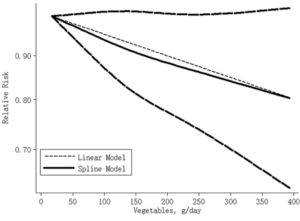
But how much veg per day?
The above chart shows that the risk of stroke decreased by 11% for every 200 g per day increment in vegetable consumption.
What mechanisms cause this reduction in risk?
The researchers consider the studies they reviewed suggested that the following biological mechanisms might explain the inverse association:
Favourable effects on other cardiovascular risk factors may also be involved, such as:
- reduced body mass index
- reduced waist circumference
- reduced total cholesterol, and
- reduced low-density lipoprotein-cholesterol12 , as well as
- reduced inflammation, and
- reduced oxidative stress 13 14
Higher fruit and veg consumption also provides other macro- and micro-nutrient benefits, including:
overall increased micronutrient intake
increased carbohydrate intake
increased fibre intake, and
reduced fat intake15
In addition, benefits from specific nutrients may be involved, such as:
increased antioxidants (vitamin C, β-carotene, and flavonoids) 20 21 , and
increased fibre 22
Conclusion
The researchers conclude that: “In summary, results from this meta-analysis support the hypothesis that consumption of vegetables and fruits could reduce the risk of stroke.”
This alone is a good enough reason to consider adopting a WFPB diet – or, at the very least, get as many fruits and vegetables into your daily diet as you possibly can.
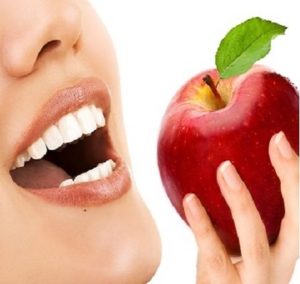
References
- State of the Nation: Stroke Statistics, February 2018 [↩]
- Feigin VL, Lawes CM, Bennett DA, Barker-Collo SL, Parag V. Worldwide stroke incidence and early case fatality reported in 56 population-based studies: a systematic review. Lancet Neurol. 2009;8:355–369 [↩]
- Wikipedia: Blue Zone [↩]
- The Blue Zones: Lessons for Living Longer From the People Who’ve Lived the Longest Mass Market Paperback – October 19, 2010. by Dan Buettner [↩]
- Exp Clin Cardiol. 2006 Summer; 11(2): 94–98. PMCID: PMC2274856. PMID: 18651042. Belgrade Satellite Symposium. Food factors for atherosclerosis prevention: Asian perspective derived from analyses of worldwide dietary biomarkers. Yukio Yamori, MD PhD, on behalf of the WHO-CARDIAC Study Group [↩]
- Indian J Community Med. 2009 Oct; 34(4): 273–275. doi: 10.4103/0970-0218.58380. PMCID: PMC2822182. PMID: 20165615. Secret of Eternal Youth; Teaching from the Centenarian Hot Spots (“Blue Zones”). Badri N Mishra [↩]
- Fruits and Vegetables Consumption and Risk of Stroke. A Meta-Analysis of Prospective Cohort Studies. Dan Hu, Junqian Huang, Yuchun Wang, Dongfeng Zhang, Yan Qu. https://doi.org/10.1161/STROKEAHA.114.004836. Stroke. 2014;45:1613-1619 [↩]
- Wikipedia: Prospective cohort study [↩]
- Woodside JV, Young IS, McKinley MC. Fruit and vegetable intake and risk of cardiovascular disease. Proc Nutr Soc. 2013;72:399–406. [↩] [↩]
- Zhao D, Qi Y, Zheng Z, Wang Y, Zhang XY, Li HJ, et al. Dietary factors associated with hypertension. Nat Rev Cardiol. 2011;8:456–465 [↩] [↩]
- Definition of microvascular function: The portion of the circulatory system composed of the smallest vessels, such as the capillaries, arterioles, and venules. [↩]
- Radhika G, Sudha V, Mohan Sathya R, Ganesan A, Mohan V. Association of fruit and vegetable intake with cardiovascular risk factors in urban south Indians. Br J Nutr. 2008;99:398–405. [↩]
- Holt EM, Steffen LM, Moran A, Basu S, Steinberger J, Ross JA, et al. Fruit and vegetable consumption and its relation to markers of inflammation and oxidative stress in adolescents. J Am Diet Assoc. 2009;109:414–421. [↩]
- Bhupathiraju SN, Tucker KL. Greater variety in fruit and vegetable intake is associated with lower inflammation in Puerto Rican adults. Am J Clin Nutr. 2011;93:37–46. [↩]
- Woodside JV, Young IS, McKinley MC. Fruits and vegetables: measuring intake and encouraging increased consumption. Proc Nutr Soc. 2013;72:236–245. [↩]
- Larsson SC, Orsini N, Wolk A. Dietary potassium intake and risk of stroke: a dose-response meta-analysis of prospective studies. Stroke. 2011;42:2746–2750. [↩]
- D’Elia L, Barba G, Cappuccio FP, Strazzullo P. Potassium intake, stroke, and cardiovascular disease a meta-analysis of prospective studies. J Am Coll Cardiol. 2011;57:1210–1219. [↩]
- Weng LC, Yeh WT, Bai CH, Chen HJ, Chuang SY, Chang HY, et al. Is ischemic stroke risk related to folate status or other nutrients correlated with folate intake? Stroke. 2008;39:3152–3158. [↩]
- Larsson SC, Männistö S, Virtanen MJ, Kontto J, Albanes D, Virtamo J. Folate, vitamin B6, vitamin B12, and methionine intakes and risk of stroke subtypes in male smokers. Am J Epidemiol. 2008;167:954–961. [↩]
- Chen GC, Lu DB, Pang Z, Liu QF. Vitamin C intake, circulating vitamin C and risk of stroke: a meta-analysis of prospective studies. J Am Heart Assoc. 2013;2:e000329. [↩]
- Wang ZM, Zhao D, Nie ZL, Zhao H, Zhou B, Gao W, et al. Flavonol intake and the risk for stroke: a meta-analysis of cohort studies [published online ahead of print date October 19, 2013]. Nutrition. doi:10.1016/j.nut.2013.10.009. [↩]
- Threapleton DE, Greenwood DC, Evans CE, Cleghorn CL, Nykjaer C, Woodhead C, et al. Dietary fiber intake and risk of first stroke: a systematic review and meta-analysis. Stroke. 2013;44:1360–1368. [↩]